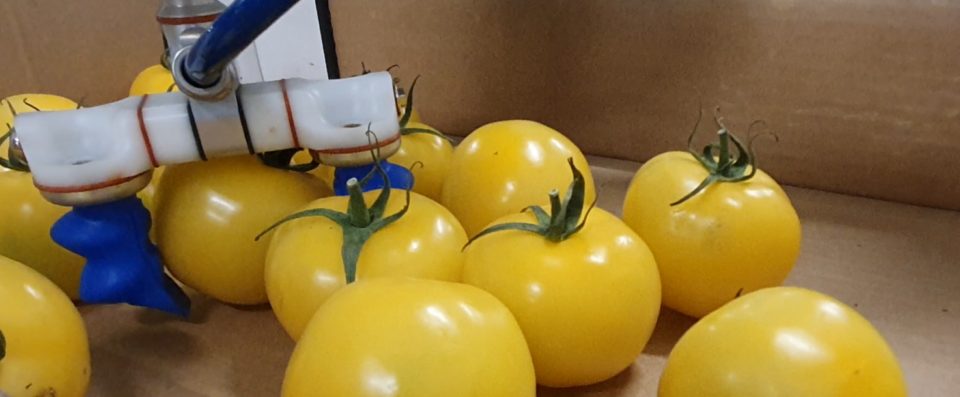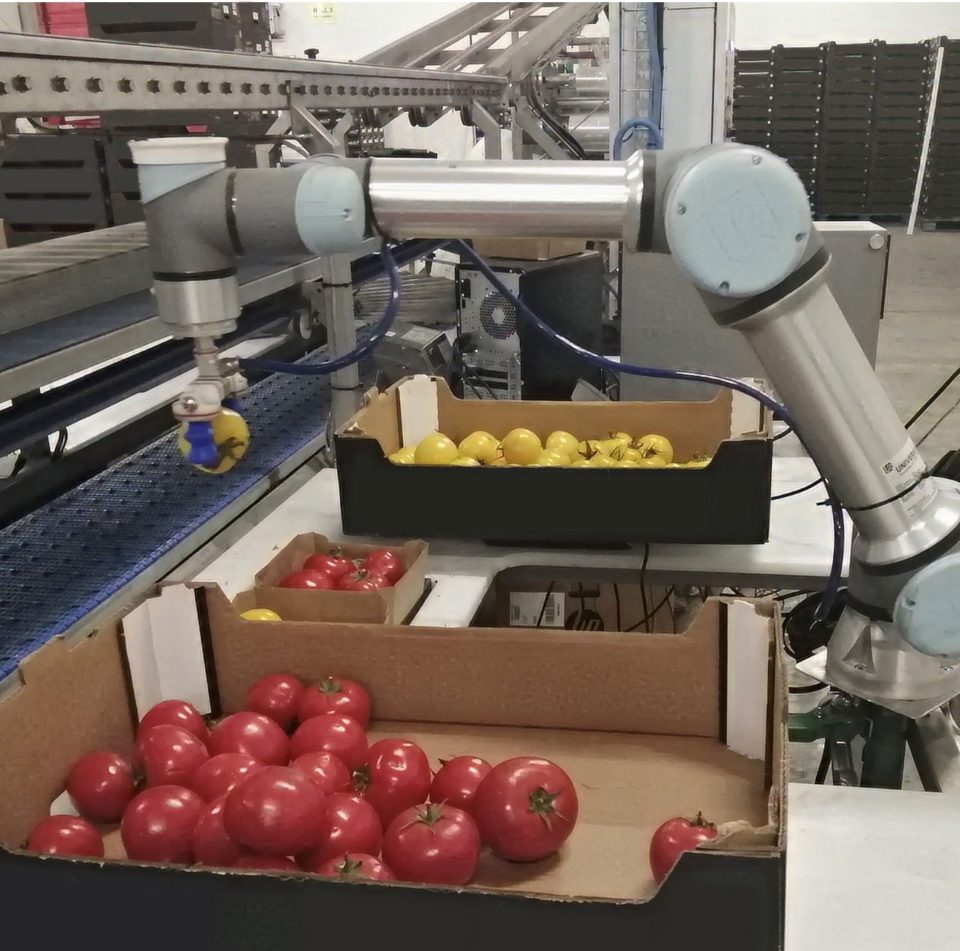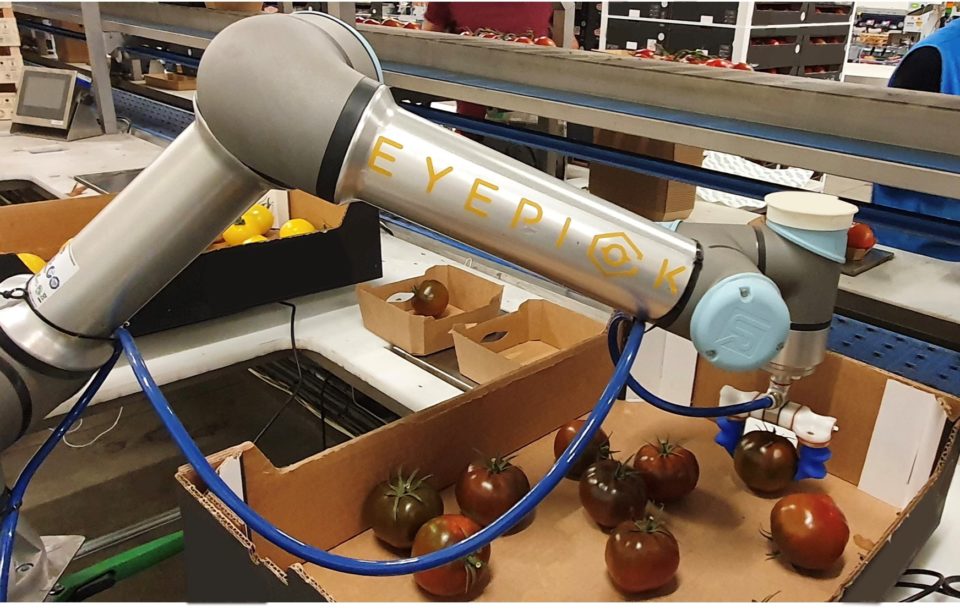
Soft-gripper technology, 3D vision, cobots, and AI team up to match human operator productivity at French produce company.
Companies in the food industry adopt robots for several different reasons — whether improving productivity and output, filling the gap created by labor shortages, or removing people from dangerous or tedious tasks. “Blind” robots can help companies automate but pairing them with other advanced automation technologies create new and previously unthought capabilities. For a French food-processing company, this meant automating a tomato sorting and packaging process.
Dealing With Delicate Product
In the food industry, products must be inspected for blemishes, diseases, colors, and other criteria before being packaged and distributed to consumers. As a result, food sorting and picking applications have traditionally relied on human inspection, but it is a tedious and painstaking process plagued by high turnover, rising labor costs, and limited productivity.

Today, however, advanced 3D vision technology combined with robotics and artificial intelligence presents significant advantages for modern food-processing sorting and packing operations. The tomato sorting is one of these cases that shifted from a purely manual task into a seamlessly automated process thanks to a unique combination of EyePick’s artificial intelligence automation software and Soft Robotics’ grippers’ dexterity.
Manually sorting and packaging fresh tomatoes requires especially careful handling. Their tender skin is easily bruised, scuffed, or gouged, which can subsequently lead to decay and ultimately product loss. In fact, bruise decay represents the greatest contributor to product loss in commercial tomato marketing channels. Identifying and handling tomatoes without destroying them presents quite a challenge.
A Food Revolution for Robots
Inspired by the way an octopus grasps and manipulates objects, the mGrip system uses an advanced material science–based approach to safely and efficiently pick up products of all types.
The company’s patented elastomeric plastic grippers are comprised of food-grade materials and feature hollow gripper fingers with flexible holds that can be controlled pneumatically at low pressure, allowing them to gently grasp objects. The mGrip design allows robots to reliably grip objects with an irregular shape or size without having to change or adapt variables of the automation system. This includes objects such as raw chicken to fragile and easily deformable components to delicate food products that traditional grippers cannot handle, such as tomatoes. The company passed IP69K ingress protection testing per International Electrotechnical Commission (IEC) standards, meaning that the grippers are protected against ingress of dust, high temperature, and high-pressure water, and thus safe for use in food processing where equipment must be carefully and rigorously cleaned and sanitized.
Training an AI System
The tomato packing operator had two main goals: First and foremost, it needed to ensure the quality of its product, minimizing or eliminating any handling damages to the delicate tomatoes. Successfully picking acceptable product and placing it into a container represented the second objective.

To accomplish the first objective, the operator used a robot with a Soft Robotics’ two-finger food certified soft gripper fixed to the arm of a collaborative robot (cobot) from Universal Robots. Developed with an advanced material science-based approach, Soft Robotics’ gripper enables the cobot to carefully pick up tomatoes and place them into a box, at great pace and without damaging them.
For the second objective, the operator worked with EyePick – a specialist in providing turnkey automation solutions for manual tasks using vision-guided robots and machine vision technologies. EyePick worked closely with the operator to understand every parameter required to assess the pass/fail criteria of a tomato, such as defects and diseases. This complicated task required extensive Artificial Intelligence training to detect with accuracy tomatoes’ defects and sicknesses. Enhanced with 3D vision, the robotic system recognizes a healthy tomato, finds the pick location, grabs the tomato, and places it into the parcel.
Picking and Sorting Automation
Deployment of Artificial Intelligence software was a straightforward effort. According to the operator, no integration issues were encountered. The robot can be operated through an intuitive user interface by a person with no technical skills. In addition, because the software and process are easily repeatable, the system is scalable. In fact, the operator expects to expand its use of 3D vision-guided robots from one to more than 10 robots in the future.

Using artificial intelligence, EyePick automated the entire picking and sorting process, a task that had been carried out manually before. Furthermore, with its advanced detection capabilities, the new system achieved better results than the manual process. On top of that, the operator now has a standardized and repeatable production process that ensures the predictability of its throughput — a critical component of any successful manufacturing operation.
“Our customers already know how important automation is; the real question is whether intelligent robots are technically potent while being economically viable,” said Mehdi Adjaoue, Co-Founder and CEO. “When paired with advanced vision abilities, the answer is often yes, and it opens the door to a new level of exciting transformations.” He added, “Through the eyes of the robot, our customers have immediate access to production monitoring, forecasts, automatic inspection and many more features.”
ROI in Under Three Years
In the food industry, where labor costs are increasing, and turnover is high, advanced automation technologies such as 3D vision and soft grippers are capable of surpassing existing solutions. Compared to traditional solutions which are often too costly, complex to implement and require custom development, the new generation of robot-based automation offers a real competitive edge both technologically and economically.
“At EyePick, we are excited to help our customers understand what intelligent robotics can offer them and to walk them through their transformation journey,” said Adjaoue.
As a result of the savings, automating the picking and sorting process at the tomato packing facility in France is expected to achieve a two- to three-year return on investment, making it an economically viable alternative to manual picking and sorting operations.
Learn more about how a Potato Producer benefited from automation.